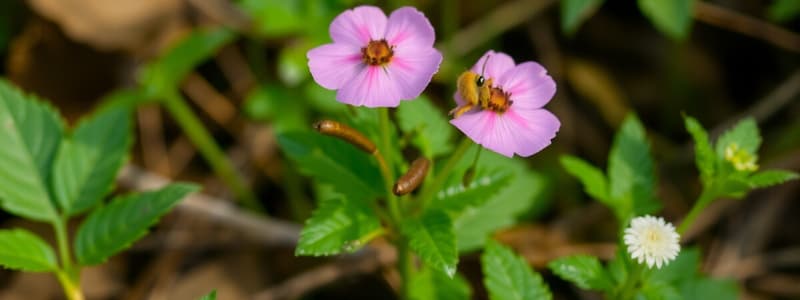Podcast
Questions and Answers
Which term correctly refers to the living components of an ecosystem?
Which term correctly refers to the living components of an ecosystem?
- Trophic levels
- Biomes
- Abiotic factors
- Biotic factors (correct)
What is an example of a mutualistic interaction in ecosystems?
What is an example of a mutualistic interaction in ecosystems?
- Deer competing for food
- Lions hunting zebras
- Bees pollinating flowers (correct)
- Fleas living on dogs
What percentage of energy is typically passed from one trophic level to the next in a food chain?
What percentage of energy is typically passed from one trophic level to the next in a food chain?
- 5%
- 10% (correct)
- 50%
- 1%
Which of the following is considered an invasive species?
Which of the following is considered an invasive species?
What role do decomposers play in ecosystems?
What role do decomposers play in ecosystems?
What major effect does the enhanced greenhouse effect have on the environment?
What major effect does the enhanced greenhouse effect have on the environment?
Which of the following best describes biological control?
Which of the following best describes biological control?
What impact does a growing human population have on ecosystems?
What impact does a growing human population have on ecosystems?
Flashcards
Ecosystem
Ecosystem
A system formed by the interaction of living organisms (biotic) and their non-living environment (abiotic).
Biotic Factors
Biotic Factors
Living components of an ecosystem.
Abiotic Factors
Abiotic Factors
Non-living components of an ecosystem.
Habitat
Habitat
Signup and view all the flashcards
Population
Population
Signup and view all the flashcards
Community
Community
Signup and view all the flashcards
Predator-Prey
Predator-Prey
Signup and view all the flashcards
Symbiosis
Symbiosis
Signup and view all the flashcards
Invasive Species
Invasive Species
Signup and view all the flashcards
Trophic Levels
Trophic Levels
Signup and view all the flashcards
Producers
Producers
Signup and view all the flashcards
Herbivore
Herbivore
Signup and view all the flashcards
Carnivore
Carnivore
Signup and view all the flashcards
Apex Predator
Apex Predator
Signup and view all the flashcards
Decomposers
Decomposers
Signup and view all the flashcards
Greenhouse Effect
Greenhouse Effect
Signup and view all the flashcards
Study Notes
Ecosystems and Components
- Ecosystems combine living (biotic) and non-living (abiotic) things.
- Abiotic factors include sunlight, water, and rocks.
- Biotic factors include trees, fish, and bacteria.
- Abiotic factors vary within ecosystems, such as temperature differences or changing salinity.
Organism Interactions
- Organisms interact in ways like collaboration (bees and flowers), mating, competition, and symbiosis (mutualism, commensalism, parasitism).
- Predator-prey relationships, such as lions and zebras, are non-symbiotic interactions.
- Predator and prey populations influence each other.
Impact of Invasive Species
- Invasive species are non-native organisms causing harm.
- Invasive species disrupt ecosystems and outcompete native species.
- Rabbits damaging Australian habitats are an example.
- Biological control methods, like the Myxoma virus, can be less effective if the target organism develops resistance.
Energy Flow in Ecosystems
- Energy flows through trophic levels, from producers to consumers.
- Trophic levels include producers (plants), primary consumers (herbivores), secondary consumers (carnivores), and tertiary consumers (apex predators).
- Herbivores eat plants; carnivores eat meat.
- Biomass is the total mass of living things.
- Only about 10% of energy is passed on to the next trophic level.
- Decomposers recycle nutrients.
Human Impact on the Environment
- Human activity increases greenhouse gases like CO₂ contributing to global warming.
- Deforestation and pollution harm ecosystems.
- Growing populations increase pressure on ecosystems, causing habitat loss and resource depletion.
Studying That Suits You
Use AI to generate personalized quizzes and flashcards to suit your learning preferences.




